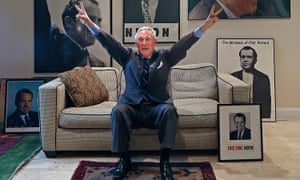Beginning with Richard Nixon in the early 1970s, the former adviser for Donald Trump has made a career of ruthless campaigning
Roger Stone says he will not 'bear false witness' against Donald Trump – video
The raid happened before dawn,
a Swat team of heavily-armed FBI agents in camouflage uniforms rushing
between Florida palm trees to confront their target. The spectacle was
laden with melodrama, surprisingly so given who had ordered it: Robert
Mueller, the special counsel in the Russia investigation who has turned
understatement into an art form.
But for the man at the receiving end of the FBI swoop, the fireworks were entirely in keeping. Roger Stone, the political consultant indicted on seven counts on Friday in Mueller’s probe into Russia interference in the 2016 US election, is a connoisseur of political pyrotechnics.The 66-year-old was one of the “ratfuckers” who engaged in dirty tricks on behalf of Richard Nixon in the early 1970s, when he was still a teenager. From there he carved out a career in the dark arts of ruthless campaigning, working for Ronald Reagan, Bob Dole and latterly Donald Trump.
His attachment to Nixon is enduring, literally so in the form of the disgraced former president’s grinning face tattooed on his back. As Stone emerged from a Fort Lauderdale courthouse following his indictment later on Friday, he alluded to his hero by making the same “V for victory” pose that Nixon adopted in 1974 as he boarded Marine One for the last time.
An arch conspiracy theorist, Stone embraced “fake news” before the term existed. His blurring of the lines between real and make-believe goes so far that it is hard to tell where the real Roger Stone ends and the fictitious Roger Stone begins, replete with top hat and tails, chauffeur-driven Jaguars and martinis mixed to a recipe given to him by Nixon, who in turn inherited it, like the V-sign, from Winston Churchill.

There are flashes of that rapscallion Stone in Mueller’s 23-page indictment. The document quotes a text message sent by Stone to a person alleged to be his go-between with WikiLeaks during the 2016 election.
In it, Stone circles back yet again to Nixon as he tries to persuade the intermediary to keep his mouth shut when facing investigators. “Stonewall it,” the text says. ‘Plead the fifth. Anything to save the plan … Richard Nixon.”
In further attempts allegedly to lean on the individual – dubbed “Person 2” in the indictment but presumed to be the radio host Randy Credico – Stone drew on a character from The Godfather: Part II. Do a “Frank Pentangeli” he exhorted, referring to the movie mobster who under duress retracts his testimony against mafia boss Michael Corleone in front of a congressional committee.
The new charges concentrate on Stone’s alleged lies about his actions concerning WikiLeaks and its release of thousands of Democratic emails reportedly hacked by Russian agents during the 2016 election. Seasoned observers of Stone will be less than astonished by such accusations, given his relativist approach to right and wrong.
As he told the Guardian in 2017: “One man’s dirty trick is another man’s civic participation.”
But Mueller goes much further. He presents a mass of detail alleging Stone was proactive both in seeking information about WikiLeaks’ hacked material and, crucially, in passing that information to senior figures within the Trump campaign.
As such, Stone acts as a lightning conductor, channeling the legal peril posed by Mueller deep into the heart of Trump’s inner circle. After the first tranche of stolen Democratic emails was released by WikiLeaks in July 2016, Mueller notes, “a senior Trump Campaign official was directed to contact Stone about any additional releases … Stone thereafter told the Trump Campaign about potential future releases of damaging material by [WikiLeaks].”
“Directed”: the word will send shivers down White House spines. Though the individual who did the directing remains a mystery, speculation will inevitably veer towards the occupant of the Oval Office.
Trump and Stone go back decades. Stone first urged the real estate developer to stand for president in the 1980s, was Trump’s main adviser when he toyed with running in 2000, and duly entered the presidential campaign when Trump took the leap in 2015.

Stone calls himself a “fervent supporter” of the president and “one of his oldest friends”. Trump, by contrast, sensing danger perhaps, has tried to put distance between them. In 2008 he told the New Yorker: “Roger is a stone-cold loser.” He went on to complain that Stone “always tries taking credit for things he never did”, inadvertently pointing towards another quality they have in common.
Stone quit the Trump campaign in August 2015. Was he fired, did he walk? The reality was, true to form, opaque. But even after departing, as Mueller spells out, Stone kept in close touch with senior figures such as Steve Bannon.
On the steps of the Fort Lauderdale courthouse following his indictment, Stone proclaimed himself “not guilty”. He declared: “I will not testify against the president”.
As a statement of intent, it was entirely unambiguous. Donald Trump should be worried.
No comments:
Post a Comment